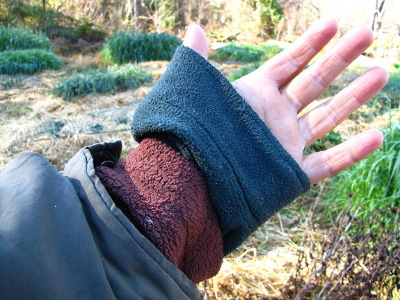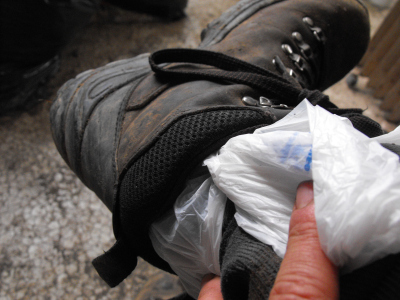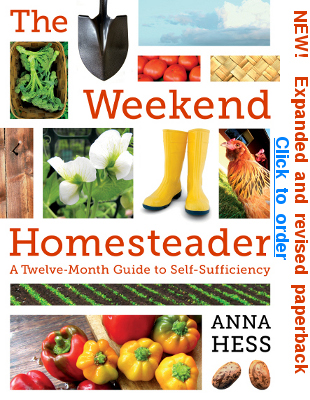
Dressing for warmth
 As I mentioned previously, I don't really
recommend planning to heat a whole
room with a backup heating arrangement. If you don't use your
backup equipment in your everyday life, it will take a long time for
that equipment to pay for itself and the heaters often won't work when
you
need them to. Instead, I recommend changing your habits so that
you heat your body instead of the room, both during outages and to
whatever extent you're comfortable with during your daily life.
The great thing about learning to stay warm without electricity or
fossil fuels is that you'll be prepared no matter how long the power
outage lasts, and will also enjoy a lower heating bill during normal
winters.
As I mentioned previously, I don't really
recommend planning to heat a whole
room with a backup heating arrangement. If you don't use your
backup equipment in your everyday life, it will take a long time for
that equipment to pay for itself and the heaters often won't work when
you
need them to. Instead, I recommend changing your habits so that
you heat your body instead of the room, both during outages and to
whatever extent you're comfortable with during your daily life.
The great thing about learning to stay warm without electricity or
fossil fuels is that you'll be prepared no matter how long the power
outage lasts, and will also enjoy a lower heating bill during normal
winters.
So how do you warm your
body instead of the room? The first step
is to invest in some winter clothes chosen for warmth and utility
instead of style. A good winter coat, a hat that covers your
ears, warm socks, sweaters, and long johns go a long way. On cold
winter days, I wear fleece long johns under normal pants, two pairs of
socks (if they fit in my boots), and on top am decked out in a t-shirt,
a thin fleece shirt, a thicker fleece shirt, and then a winter
coat. Throw a wool hat on my head and some good gloves on my
hands and I'm quite comfortable even sitting still at 40 or 50 degrees
Fahrenheit. If you head down to the local goodwill, you can
probably find most of these pieces of clothing for just a few bucks
apiece.
Three environmental
conditions can make the outfit above useless,
though: wind, wet, and constriction. I'll start with the last,
which is the least intuitive. When you're building a house and
adding insulation to the walls, you'll soon learn that you can't cram
two layers of insulation into the space meant for one layer and get
twice the protection from cold. Instead, that double layer of
insulation will actually work less
well than a single, properly installed layer would have.
Insulation --- and that includes your winter clothes --- works by
creating pockets that trap air in place. So if you put on two
pairs of socks and cram your feet into boots meant for one pair, your
feet will be colder than if you'd only put on one pair because the
constricted clothing will push out all the insulating air
pockets. Ditto if you try to wear long johns under close-fitting
jeans. That's why, when planning your winter layers, you'll need
to choose some clothes a bit bigger than normal to go on the outside.
You're probably more
familiar with the way wind and rain can make you
cold despite lots of insulative clothing. If you're going to be
inside during cold weather, you probably won't have to worry much
about these problems, but you should plan ahead in case you need to go
out. A waterproof wind-breaker on top of your other clothes goes
a long way toward keeping both water and chilly winds from
penetrating. This is especially important if you use synthetic
fleece clothes, which wind cuts right through.
You also need to think
about water that starts on the inside of your
clothes --- sweat. If you're outside chopping wood and notice
that you're starting to heat up, take off layers until you're
comfortable again. Otherwise, your sweat will quickly chill your
body
once you stop moving.
 Finally, keep some plastic grocery bags on hand to deal
with wet
feet. Boots eventually spring a leak during slogs through the
snow, and wet feet make even the most cheerful person cranky. If
you can put on dry socks and slip each socked feet into a grocery bag
apiece before putting on your boots, the plastic layer will keep water
in your boots from seeping into your socks and coming in contact with
your skin. You may look like a homeless person, but you'll be a warm homeless person.
Finally, keep some plastic grocery bags on hand to deal
with wet
feet. Boots eventually spring a leak during slogs through the
snow, and wet feet make even the most cheerful person cranky. If
you can put on dry socks and slip each socked feet into a grocery bag
apiece before putting on your boots, the plastic layer will keep water
in your boots from seeping into your socks and coming in contact with
your skin. You may look like a homeless person, but you'll be a warm homeless person.
I
hope you enjoy this excerpt from Weekend
Homesteader: December.
The 99 cent ebook walks you through the basics of planting your first
fruit trees,
staying warm without electricity, understanding the uses of essential
tools, and turning trash into treasures. If you're interested in
other aspects of basic emergency preparedness, Weekend
Homesteader: November gives tips on storing drinking water and the
upcoming Weekend Homesteader: January will cover backup lighting
options.
 This post is part of our Emergency Warmth lunchtime series.
Read all of the entries: This post is part of our Emergency Warmth lunchtime series.
Read all of the entries: |
Want more in-depth information? Browse through our books.
Or explore more posts by date or by subject.
About us: Anna Hess and Mark Hamilton spent over a decade living self-sufficiently in the mountains of Virginia before moving north to start over from scratch in the foothills of Ohio. They've experimented with permaculture, no-till gardening, trailersteading, home-based microbusinesses and much more, writing about their adventures in both blogs and books.
Want to be notified when new comments are posted on this page? Click on the RSS button after you add a comment to subscribe to the comment feed, or simply check the box beside "email replies to me" while writing your comment.

I've always been a big fan of layers when it comes to cold and I am always shocked when I meet people who seem almost disgusted by the idea of putting something on when they are cold.
Several friends and I lived overseas for a few years and the winters never got below 10c. The apartment we shared, like most others in the country, had windows with poor insulation and no heating. One roomate and I solved the problem of cold nights by covering our windows with towels and sleeping with shirts and socks. Crisis averted. The other two went out and bought a heater for almost 100$ because they refused to not sleep naked for the six weeks of the year that it was needed.
Growing up, the heat was only turned about 65 when it was time for showers. At our old apartment, my wife and I kept the heat at 60 throughout the winter.
On tip I would definitely recommend when keeping the heat low in the winter: move the bed away from exterior walls if at all possible. Especially in poorly insulated homes like our old apartment was. There was frequently frost on the inside of our windows, so we know the exterior wall was frequently below 30, but the interior walls were a comparatively toasty 60.
I'm currently working as a flagger, so I'm no stranger to standing still in cold weather. Over the years, I've built up a pretty good collection of cold weather gear, but I still struggle with my feet. Combinations of thermal sock liners, regular cotton socks, and wool boot socks only take me down to about 40 degrees and then my toes start to get cold. I wanted to try two pairs of wool socks, but that combo simply doesn't fit in my boots.
Great tip about interior vs. exterior walls! I would take that a step further and say that if you're going to commit to heating a whole room and don't have one that's passive solar heated, you should probably choose a room in the center of the house.
In our trailer, the barely insulated floor is the coldest part. Stay a foot or so above it, and everything is much warmer....
Cold hands and feet are often a circulation problem. Tough to do when you're working as a flagger, but I find that if I wake up with cold hands, going for a walk warms then right up.